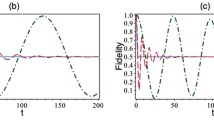Abstract
While it has often been proposed that, fundamentally, Lorentz-invariance is not respected in a quantum theory of gravity, it has been difficult to reconcile deviations from Lorentz-invariance with quantum field theory. The most commonly used mechanisms either break Lorentz-invariance explicitly or deform it at high energies. However, the former option is very tightly constrained by experiment already, the latter generically leads to problems with locality. We show here that there exists a third way to integrate deviations from Lorentz-invariance into quantum field theory that circumvents the problems of the other approaches. The way this is achieved is an extension of the standard model in which photons can have different speeds without singling out a preferred restframe, but only as long as they are in a quantum superposition. Once a measurement has been made, observables are subject to the laws of special relativity, and the process of measurement introduces a preferred frame. The speed of light can take on different values, both superluminal and subluminal (with respect to the usual value of the speed of light), without the need for Lorentz-invariance violating operators and without tachyons. We briefly discuss the relation to deformations of special relativity and phenomenological consequences.

Similar content being viewed by others
Notes
The ‘Box-problem’ discussed in reference [20, 21] is circumvented because rather than there being two photons with different speeds, there is one photon in a superposition of different speeds. The measurement is either made in the laboratory frame, in which case the bomb blows up and the observer in the satellite agrees, or it is made in the satellite frame, in which case the bomb does not blow up and the observer in the lab agrees. The situation is entirely symmetric as long as both frames represent identical measuring processes with some relative velocity.
References
Mattingly, D.: Modern tests of Lorentz invariance. Living Rev. Relativ. 8, 5 (2005). arXiv:gr-qc/0502097
Kostelecky, V.A., Russell, N.: Data tables for Lorentz and CPT violation. Rev. Mod. Phys. 83, 11 (2011). arXiv:0801.0287 [hep-ph]
Maccione, L., Liberati, S., Celotti, A., Kirk, J.G.: New constraints on Planck-scale Lorentz violation in QED from the Crab Nebula. J. Cosmol. Astropart. Phys. 0710, 013 (2007). arXiv:0707.2673 [astro-ph]
Amelino-Camelia, G.: Testable scenario for relativity with minimum-length. Phys. Lett. B 510, 255 (2001). arXiv:hep-th/0012238
Kowalski-Glikman, J.: Observer independent quantum of mass. Phys. Lett. A 286, 391 (2001). arXiv:hep-th/0102098
Amelino-Camelia, G.: Doubly special relativity. Nature 418, 34 (2002). arXiv:gr-qc/0207049
Magueijo, J., Smolin, L.: Generalized Lorentz invariance with an invariant energy scale. Phys. Rev. D 67, 044017 (2003). arXiv:gr-qc/0207085
Amelino-Camelia, G.: Relativity in space-times with short distance structure governed by an observer independent (Planckian) length scale. Int. J. Mod. Phys. D 11, 35 (2002). gr-qc/0012051
Amelino-Camelia, G.: Doubly-special relativity: facts, myths and some key open issues. Symmetry 2, 230 (2010). arXiv:1003.3942 [gr-qc]
Snyder, H.S.: Quantized Space-Time. Phys. Rev. 71, 38 (1947)
Majid, S., Ruegg, H.: Bicrossproduct structure of kappa poincare group and non-commutative geometry. Phys. Lett. B 334, 348–354 (1994). hep-th/9405107
Kowalski-Glikman, J., Nowak, S.: Doubly special relativity and de sitter space. Class. Quantum Gravity 20, 4799–4816 (2003). hep-th/0304101
Amelino-Camelia, G., Smolin, L., Starodubtsev, A.: Quantum symmetry, the cosmological constant and Planck scale phenomenology. Class. Quantum Gravity 21, 3095 (2004). arXiv:hep-th/0306134
Smolin, L.: Could deformed special relativity naturally arise from the semiclassical limit of quantum gravity? (2008). arXiv:0808.3765 [hep-th]
Kowalski-Glikman, J., Starodubtsev, A.: Effective particle kinematics from quantum gravity. Phys. Rev. D 78, 084039 (2008). arXiv:0808.2613 [gr-qc]
Freidel, L., Kowalski-Glikman, J., Smolin, L.: 2+1 gravity and doubly special relativity. Phys. Rev. D 69, 044001 (2004). arXiv:hep-th/0307085
Bojowald, M.: Quantum geometry and quantum dynamics at the Planck scale. AIP Conf. Proc. 1196, 62 (2009). arXiv:0910.2936 [gr-qc]
Kowalski-Glikman, J.: Doubly special relativity: facts and prospects. In: Oriti, D. (ed.) Approaches to Quantum Gravity, pp. 493–508. gr-qc/0603022
Smolin, L.: Classical paradoxes of locality and their possible quantum resolutions in deformed special relativity. arXiv:1004.0664 [gr-qc]
Hossenfelder, S.: The box-problem in deformed special relativity. arXiv:0912.0090 [gr-qc]
Hossenfelder, S.: Bounds on an energy-dependent and observer-independent speed of light from violations of locality. Phys. Rev. Lett. 104, 140402 (2010). arXiv:1004.0418 [hep-ph]
Jacob, U., Mercati, F., Amelino-Camelia, G., Piran, T.: Modifications to Lorentz invariant dispersion in relatively boosted frames. Phys. Rev. D 82, 084021 (2010). arXiv:1004.0575 [astro-ph.HE]
Amelino-Camelia, G., Matassa, M., Mercati, F., Rosati, G.: Taming nonlocality in theories with Planck-scale deformed Lorentz symmetry. Phys. Rev. Lett. 106, 071301 (2011). arXiv:1006.2126 [gr-qc]
Smolin, L.: On limitations of the extent of inertial frames in non-commutative relativistic spacetimes. arXiv:1007.0718 [gr-qc]
Amelino-Camelia, G., Freidel, L., Kowalski-Glikman, J., Smolin, L.: The principle of relative locality. Phys. Rev. D 84, 084010 (2011). arXiv:1101.0931 [hep-th]
Hossenfelder, S.: Comments on nonlocality in deformed special relativity, in reply to arXiv:1004.0664 by Lee Smolin and arXiv:1004.0575 by Jacob et al. arXiv:1005.0535 [gr-qc]
Hossenfelder, S.: Reply to arXiv:1006.2126 by Giovanni Amelino-Camelia et al. arXiv:1006.4587 [gr-qc]
Hossenfelder, S.: Comment on arXiv:1007.0718 by Lee Smolin. arXiv:1008.1312 [gr-qc]
Friedman, J., Morris, M.S., Novikov, I.D., Echeverria, F., Klinkhammer, G., Thorne, K.S., Yurtsever, U.: Cauchy problem in space-times with closed timelike curves. Phys. Rev. D 42, 1915 (1990)
Visser, M.: The quantum physics of chronology protection. gr-qc/0204022
Geroch, R.: Faster than light? arXiv:1005.1614 [gr-qc]
Babichev, E., Mukhanov, V., Vikman, A.: k-Essence, superluminal propagation, causality and emergent geometry. J. High Energy Phys. 0802, 101 (2008). arXiv:0708.0561 [hep-th]
Thompson, R.T., Ford, L.H.: Spectral line broadening and angular blurring due to spacetime geometry fluctuations. Phys. Rev. D 74, 024012 (2006). gr-qc/0601137
Goklu, E., Lammerzahl, C.: Metric fluctuations and the weak equivalence principle. Class. Quantum Gravity 25, 105012 (2008). arXiv:0801.4553 [gr-qc]
Acknowledgements
I thank Ben Koch, Jakub Mielczarek, Stefan Scherer and Lee Smolin for helpful feedback and discussions, and Sean Carroll for drawing my attention to Reference [31].
Author information
Authors and Affiliations
Corresponding author
Rights and permissions
About this article
Cite this article
Hossenfelder, S. Quantum Superpositions of the Speed of Light. Found Phys 42, 1452–1468 (2012). https://doi.org/10.1007/s10701-012-9678-0
Received:
Accepted:
Published:
Issue Date:
DOI: https://doi.org/10.1007/s10701-012-9678-0




